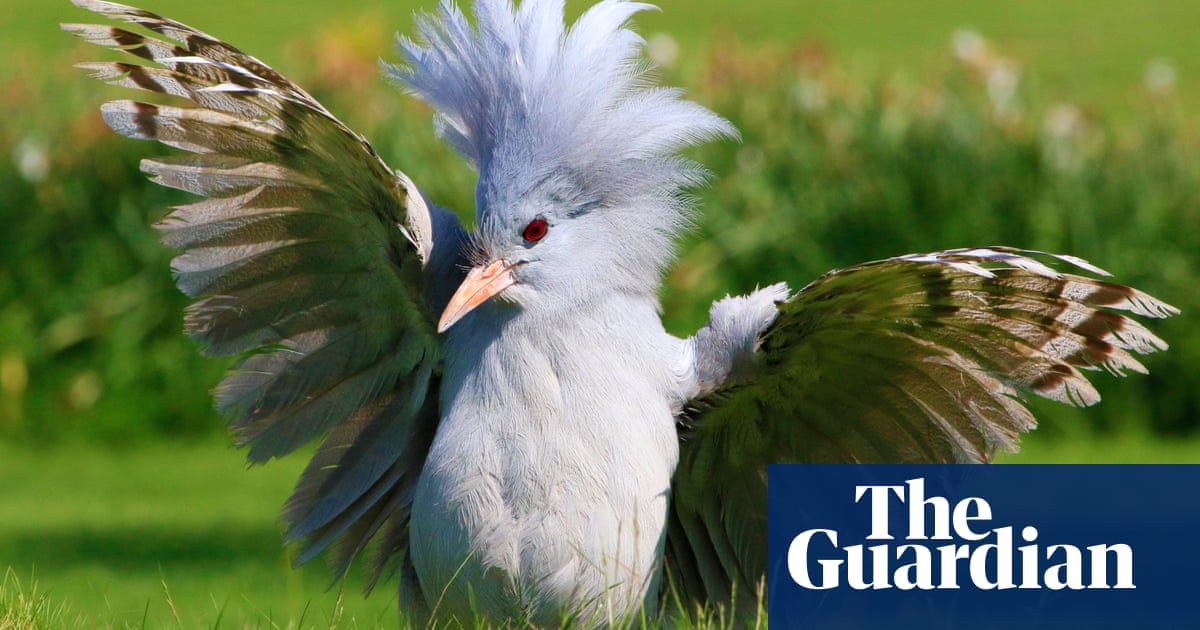In the early hours of the morning, a powerful cry echoes through the rainforest in Farino, in southern New Caledonia. What sounds like a dog barking is actually the song of the cagou. The shy bird, with grey plumage and a distinctive crest, is difficult to see through the trees.
The striking bird is an important cultural symbol in the French Pacific territory, decorating postage stamps and banknotes. When it feels under attack, the cagou stands up straight and its crest shoots in the air as it approaches an opponent and growls. Yet the cagou, which is endemic to New Caledonia, faces a series of threats to its survival.
The bird is considered endangered and experts estimate there are about 2,000 in New Caledonia. Scientist Jörn Theuerkauf, who studies the birds in Farino, says a “massacre” by predators in 2017 killed about three-quarters of the population in the area. A similar incident three years later further hurt its numbers. Cagous can’t fly and don’t run quickly, so they are easy prey for stray dogs, cats and wild pigs, which trample the nests, roughly built on the ground.
But efforts to preserve and grow the population are paying off. A series of steps to protect the birds – including managing threats and tracking behaviour – have seen their numbers swell.
“The population [in Farino] has probably tripled since 2017. We are therefore soon at the maximum number of birds possible in the park,” Theuerkauf says.
Theuerkauf and his colleague Henri Bloc, who works for conservation group Nature Warden brigade, have studied the birds at the sanctuary in Farino for more than a decade.
So cute.
The kagu or cagou (Rhynochetos jubatus) is a crested, long-legged, and bluish-grey bird endemic to the dense mountain forests of New Caledonia. It is the only surviving member of the genus Rhynochetos and the family Rhynochetidae. pic.twitter.com/zEtTDDaF4Q
— Aida Greenbury (@AidaGreenbury) April 11, 2022
The pair remember a morning in 2017, when they found at least 30 dead cagous with dog bites on their bodies. In 2020, a similar incident happened and led to the park banning dogs, including those on a leash, and also introducing programs to hunt predators.
“Once a week, early in the morning, hunters look for stray dogs to eradicate them,” Bloc says.
Since 2015, they have also been monitoring cagous more closely. Now, Bloc says they follow 15 “families”, which consist of one female and several males, using transmitters and antennae placed on the backs of the birds. The devices map their movements, which can stretch up to 15 hectares. Bloc estimates roughly 1,200 cagous live in the park, and they now track their travel to identify their territory as well as monitor predators.
“Transmitters allow us to follow them around the park and find nests. We installed cameras to monitor the nest until the chick hatches,” Bloc says.
After taking these steps, Theuerkauf says families began to form again. The birds reproduced and in recent years the number of cagous has jumped. The numbers are nearly at the park’s limit, which Theuerkauf said “we cannot go above it because afterwards there is not enough food”.
The cagou are territorial animals and defend their land so the more there are, the more conflict that arises between the birds. In these situations, the cagou’s crest rises on its head in a sign of discontent. The feathers on top of its head shoot up like a crown, before the bird slowly opens its wings.
Efforts to protect the population have been going on for decades, including key program that began in the 1980s, when the cagou was first listed on the convention on international trade of endangered species (Cites). At that time, a zoo and forest park in Noumeā began to raise cagous in captivity and release them at the Rivière Bleue provincial park, a couple of hours away.
Director Marianne Bonzon says the program ran for almost 20 years. “Dozens of specimens were released, which made it possible to repopulate the park and it worked well,” she says.
Now, in 2024, the zoo takes care of 16 cagous, and the females have one or two chicks a year. They usually release them into the Rivière Bleue park after a few months, once they are ready to adapt in the wild.
“We don’t feed them one day per week so they have no choice but to find food by themselves,” Bonzon says.
In addition to the birds they breed in captivity, animal keepers welcome wild cagous. Injured animals are brought to the zoo’s vets and cared for as long as needed, before they are released into the wild, Bonzon says.
In 1984, about 60 birds were thought to be living in Rivière Bleue park. Now, the park manager, Jean-Marc Meriot, estimates there are more than 1,000. Meriot has been around the cagou for more than 25 years.
“We now have forest areas with new pairs of cagous,” he says. Twice a month, authorities conduct pest eradication and Meriot says about 60 wild pigs and several stray dogs are killed each year.
“The cagou population is doing very well, it is constantly expanding and things couldn’t be better,” Meriot says.
